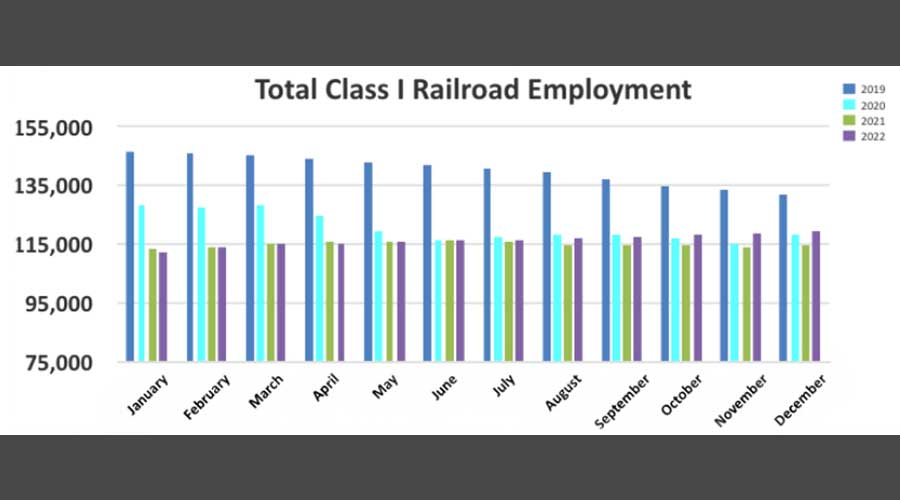Railroads’ Overarching Performance Considerations Undergoing Mindset Shift
In this three-part series, we’re exploring railroads’ shifting priorities as they work to keep operating ratios in check — and how they relate to proper staff training. We’re sharing ways to get ahead of these rising costs as they seek to restore service to pre-pandemic levels.
In the first part of our series, we explored How Virtual Simulations Can Support Railroads in Service Recovery; and the second article was a deep dive into the asset management side of things, with The Relationship Between Asset Management and Employee Training. In this piece, we’re bring it all together in a discussion around cost control, and the mindset shift that is happening in the industry, spurred on by firm STB guidance.
As Trains.com reported last year, “Railroad performance metrics need to improve soon, STB Chairman Martin J. Oberman told the railroads. ‘The country is going to have a lot of trouble if 30 days and 60 days from now these numbers aren’t much different,’ he says. ‘If we’re relying only on hiring, I don’t see you being able to get there in 30, or 60 or 90 days. We’re going to miss the planting season, we’ve got fuel problems. That’s what I’m concerned about.’”
 Oberman cautioned railroads against focusing solely on operating ratios, and questioned the industry’s all-in approach to PSR in light of a labor shortage that has hindered nationwide transport.
Oberman cautioned railroads against focusing solely on operating ratios, and questioned the industry’s all-in approach to PSR in light of a labor shortage that has hindered nationwide transport.
And as the industry gears up to meet these challenges head-on, they’re left with a two-front dilemma: rethinking cost control, while demonstrating PSR as an asset to their respective operations.
Here are some ideas that will help you navigate this changing landscape.
Rethinking Cost Control
As we touched on in our first article in the series, operating ratios can be reduced with the adoption of advanced technologies, namely training simulations. But the development of these trainings is nuanced and touches upon a wide swatch of considerations, including asset management – a topic we covered in part two. But, in fact, the conversation takes us beyond both.
Now that we have a clearer understanding of the struggles from both the worker and asset management components, we can better frame the mindset shift that is happening in the industry for what it is – a way to not only get costs in check, but to restore service to exceed pre-pandemic expectations! And it happens by applying the same themes that create the framework of PSR, thus demonstrating value there as well.
Simulations Designed with PSR Themes as Guidance
Railroads have recognized that the time is ripe for change, and many have adopted sims as part of their training and asset management protocols as a result. They view long-term cost control as an integral part of today’s operating budget and they’re building on the top themes prevalent in PSR when designing these trainings to revitalize subpar services as they exist today:
- Provide service: do what you say you are going to do.
- Control costs: eliminate unnecessary costs.
- Optimize assets: use assets more efficiently and productively.
- Operate safely: safety is the top priority.
- Develop people: cultivate the best team of railroaders.
All of this combines to put railroads on a path to exceed pre-pandemic service expectations.
Exceeding Pre-pandemic Service Expectations
The pandemic created challenges, but also opportunities. Reducing headcount assets was something that was already in play before 2020 hit, but pulling the lever on reducing asset management costs was another story. And it may not have come to the forefront had we not experienced such an extreme change in the intermodal landscape.
The challenges are very real, and we spoke to them in the first part of this series, but the opportunities have only recently moved to the forefront, advanced by forward-thinking industry leaders. And the great part here is this: we’ve only just begun to help them realize the full potential of the safety, cost savings and industry revitalization made possible by simulation training.
Every function in a workplace requires training, particularly a craft requiring deep expertise and both mechanical and technical prowess. Historically, this intelligence was orally transferred from one generation to the next, but as years passed and railroaders did not stay in one profession for 20 years any longer, this became unworkable. Enter classroom-based trainings, followed by computer-based trainings that did a passable job of training new hires, particularly when accompanied by yearly refreshers.
 But learning gaps arose and more training was required, resulting in more costs – so training budgets were expanded to accommodate.
But learning gaps arose and more training was required, resulting in more costs – so training budgets were expanded to accommodate.
When 2020 hit in the midst of railroads’ PSR-adaptation, the training budget could not keep up with the number of new hires required, nor adequately accommodate the work missed by craft experts pulled away to facilitate these trainings.
But those with sims in place were better prepared to adapt, with workers confidently entering new roles – and railroads confident their new hires were learning critical things, with fewer (if any) training gaps than ever before. The struggle now is comparing sim training to those still happening via traditional or CBT-based methods. And this is where the exceptional savings also exist, allowing railroads to exceed pre-pandemic expectations there as well.
The time for simulation training in railroading is certainly upon us – and railroads are taking note with a variety of sims already in play. The potential for so much more is palpable. And with the STB demanding quick action, we’d here to help the industry move forward rapidly. Reach out and let’s get your operations aligned with STB expectations!


